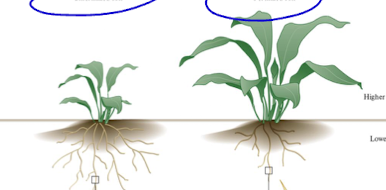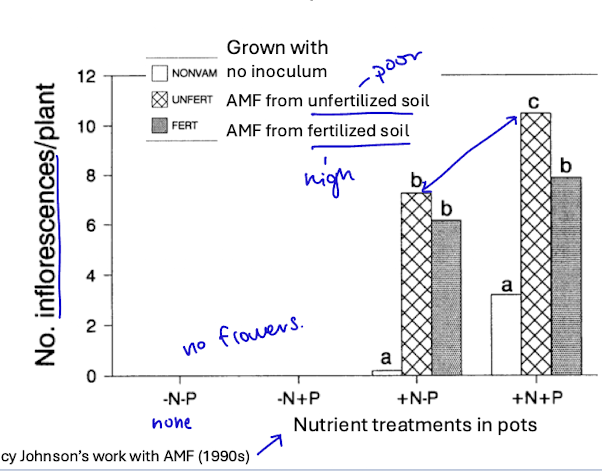mutualism/parasitism
1/32
There's no tags or description
Looks like no tags are added yet.
Name | Mastery | Learn | Test | Matching | Spaced |
|---|
No study sessions yet.
33 Terms
why do we care about mutualism and parasitism?
crop and forest productivity, ecosystem functioning - mycorrhizae
crop pollination, honey production, and pollinator networks
parasites and diseases
symbiosis
intricate and long term living of two organisms
includes commensalism, mutualism and parasitism
often species specific
form may be contingent on environmental factors depending on context`
facultative symbiosis
occuring optionally
no dependence on specific partners, low risk of extinction if a partner goes extinct
obligate symbiosis
occuring by necessity
dependence on specific partners, high risk of extinction if a partner goes extinct
ex specialist pollinators
symbiosis gradient
gradients from mutualistic - commensal - parasitic
from facultative - obligate
commensalism
ecological interaction which is beneficial for one species but neutral for the other
ex barnacles benefit from whales, but whales are mostly neutral
commensalism - barnacles and whales
barnacles benefit from whales, substrate and dispersal
only found on whales - obligate, but some are facultative
whales experience no harm and no benefit usually, facultative
sometimes barnacles can be positive and act like armour on their fins, or too many can cause drag and spend more energy, or cause skin conditions
parasitism
ecological interaction that is beneficial for one organism but detrimental to the other
ex ticks obligate symbiosis on host animal
ex ticks and host - parasitism
ticks are obligate arachnoid ectoparasites, and feed externally on blood of other animals
host animal is harmed through blood removal and disease risk
other parasitism examples
mistletoes - hemiparasitic plants
tapeworms - in digestive tracts
tongue eating lice - crustaceans feed on blood and mucus in fish mouths
herbivores vs plant parasite?
parasite host interactions are similar to those seen in predator prey relationships or herbivore plant - exploitative
the difference is that a parasite forms a intricate and long term relationship with its host
parasites altering host behaviour
ex european starling, isopods and thorny parasitic worm
the worm lays eggs in the intestines of the bird, the eggs are then shed with feces, next a isopod eats the feces and the worm larvae will develop within it (intermediate host), the larvae alters the isopod behaviour to spend time in open areas where it is more likely to be eaten by the starling (primary host) and the cycle continuous
primary host vs intermediate host
parasite reaches adult stage and sexual maturity, vs parasite grows
red queen hypothesis
species must evolve to keep up with the evolution in their parasites and vice versa
perpetual co evolution between the two can be compared to an arms race
it takes all the running you can do to keep in the same place
mutualism
ecological interaction which is beneficial for both organisms
ex mychorrhizae
mycorrhizal fungi (MF)
plants benefit from increased nutrient uptake in the soil, while the fungi benefits from plants through the consumption of root exudates - carbs
can be parasitic, but environmentally dependent
arbuscular mycorrhizal fungi (AMF)
penetrate the cortical cells of plant roots
more mutualistic when grown in nutrient poor soil
occurs in 80% of plant species
Ectomycorrhizal fungi (EMF)
do not penetrate cortical cells
2% of plants species - conifers, blueberry - northern biome species

AMF and nutrient poor soil
predicted that in nutrient poor soil there is more carbohydrates exudate to the roots because more energy/allocation to the roots for the same growth
in nutrient rich soils, more energy is spent on the above ground foliage meaning less carbs in the roots
this means that MF colonizing in nutrient rich soil is going to be more aggressive in carb acquisition at the expense of host
experiement tested this with fertilized and unfertilized soil which was sterilized or not

MF and mutualism-parsitism continuum
plants were grown with and without MF and the change in biomass was compared
some plants increased growth with MF while others had no impact and others decreased
sometimes the fungus takes from the plant and does not give as much as it should

reciprocal parasitism
natural selection should favour a species own fitness rather than simply help organisms
in reference to the net effects of mutualism
mutualistic interactions
corals and zooxanthellae, lichens - fungi and algae, legumes and rhizobia bacteria - nitrogen fixation
corals and zooxanthellae
obligate interactions
coral and algae depend on each other for survival, when the coral becomes stressed - increased temp or pollution, the algae leaves the coral
this causes the coral to be bleached and vulnerable, the coral loses its main food source and is susceptible to disease
what can cause coral bleaching
increased ocean temps, runoff and pollution, overexposure to sunlight, and extreme low tides
lichens
symbiotic mutualism
a fungal biofilm and algae work together, the algae providing photosynthesis and the fungi providing structure and retaining moisture/protection
allows for the existence in tundra and other extreme climates
non-symbiotic mutualism
not all interactions are going to the intricate and constant body to body
ex pollinators, seed dispersers, cleaners like birds on cows or smaller fish and other fish
pollination
the transfer of pollen grains for reproduction by wind, water, animals or within the same flower
animals as pollen dispersal vectors
plant species which rely on pollinator usually have co evolved pollinators
there is a cost to the plant, such as energy expended for attraction rather than reproduction
the animal also has a cost, such as energy wasted searching for a specific plant → reciprocal parasitism but usually the benefits outweigh the plants
attracting pollinators adaptations
flower colour and scent
butterflies attracted to bright like yellow, orange, red, bees are red blind so prefer yellow or blue and nocturnal moths like scent released during the night
pollinators may be rewarded such as by pollen, nectar or the prospect of mating with a female
pollinators and ecosystem services
functions provided by nature which improve and sustain human wellbeing
bees as commercial pollinators
1/3 of global food production due to pollination
30$ bil USD per year
facilitated by managed honeybees maintained by humans
colony collapse disorder (CCD)
many colonies are lacking worker bees and cannot sustain themselves despite abundant honey
about 30% loss each winter since 2006, 3x higher than normal
possible reasons still investigated but thought to be due to parasites, pesticide poisoning, stress, inadequate forage
measures to protect pollinators
flower strips, landscape heterogeneity
in europe after have saw in 75% loss in insect biomass in 27 years